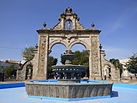This article needs additional citations for verification. (December 2021) |
Zapopan | |
|---|---|
City and municipality | |
Clockwise from left: Zapopan Basilica, Monumento del Maíz, Andares Shopping Mall, Puerta de Hierro residences, Municipal Hall, Arcos | |
|
| |
 | |
| Coordinates: 20°43′13″N 103°23′31″W / 20.72028°N 103.39194°W | |
| Country | |
| State | |
| Founded | December 8, 1541 |
| Founded as | Nuestra Señora de la Concepción de Tzapopan |
| Municipal Status | 1825 |
| Government | |
| • Municipal president | Juan José Frangie Saade |
| Area | |
• Municipality | 893.15 km2 (344.85 sq mi) |
| Elevation (of seat) | 1,571 m (5,154 ft) |
| Population (2020) Municipality | |
• Municipality | 1,476,491 |
| • Rank | 16th in North America 7th in Mexico |
| • Seat | 1,026,492 |
| • Seat density | 1,035/km2 (2,680/sq mi) |
| Time zone | UTC−6 (CST) |
| Postal code (of seat) | 45010 |
| Area code | 33 |
| Demonym | Zapopano |
| Website | (in Spanish) Municipal official site |
Zapopan (Spanish pronunciation: [saˈpopan]) is a city and municipality located in the Mexican state of Jalisco. Part of the Guadalajara Metropolitan Area, the population of Zapopan city proper makes it the largest city in the state, after the population of Guadalajara proper. It is best known as the home of the Virgin of Zapopan, an image of the Virgin Mary which was made in the 16th century. This image has been credited with a number of miracles and has been recognized by popes and even visited by Pope John Paul II.[1] The municipality is also the home of the Centro Cultural Universitario, which contains one of the most important concert venues in Latin America[2] and is the home of the new stadium for the C.D. Guadalajara.[3]
The name Zapopan means "among the sapote trees". It derives from the Nahuatl word tzapotl "sapote" with the addition of the locative suffix -pan.[1] It also has the nickname of “ex Villa Maicera” ("former Corn Village"), as it used to be a major producer of corn.[2] Its seal was designed by José Trinidad Laris in 1941 for the 400th anniversary of the city's founding.[1]
- ^ a b c "Enciclopedia de los Municipios de México Estado de Jalisco Zapopan" (in Spanish). Mexico: INAFED. Archived from the original on June 16, 2011. Retrieved January 19, 2010.
- ^ a b "Breve historia del municipio de Zapopan" [Brief history of the municipality of Zapopan] (in Spanish). Zapopan, Mexico: Municipality of Zapopan. Retrieved January 19, 2010.
- ^ "Estadio Chivas" [Chivas Stadium] (in Spanish). Guadalajara, Mexico: Chivas Football Club. Archived from the original on January 15, 2010. Retrieved January 19, 2010.










